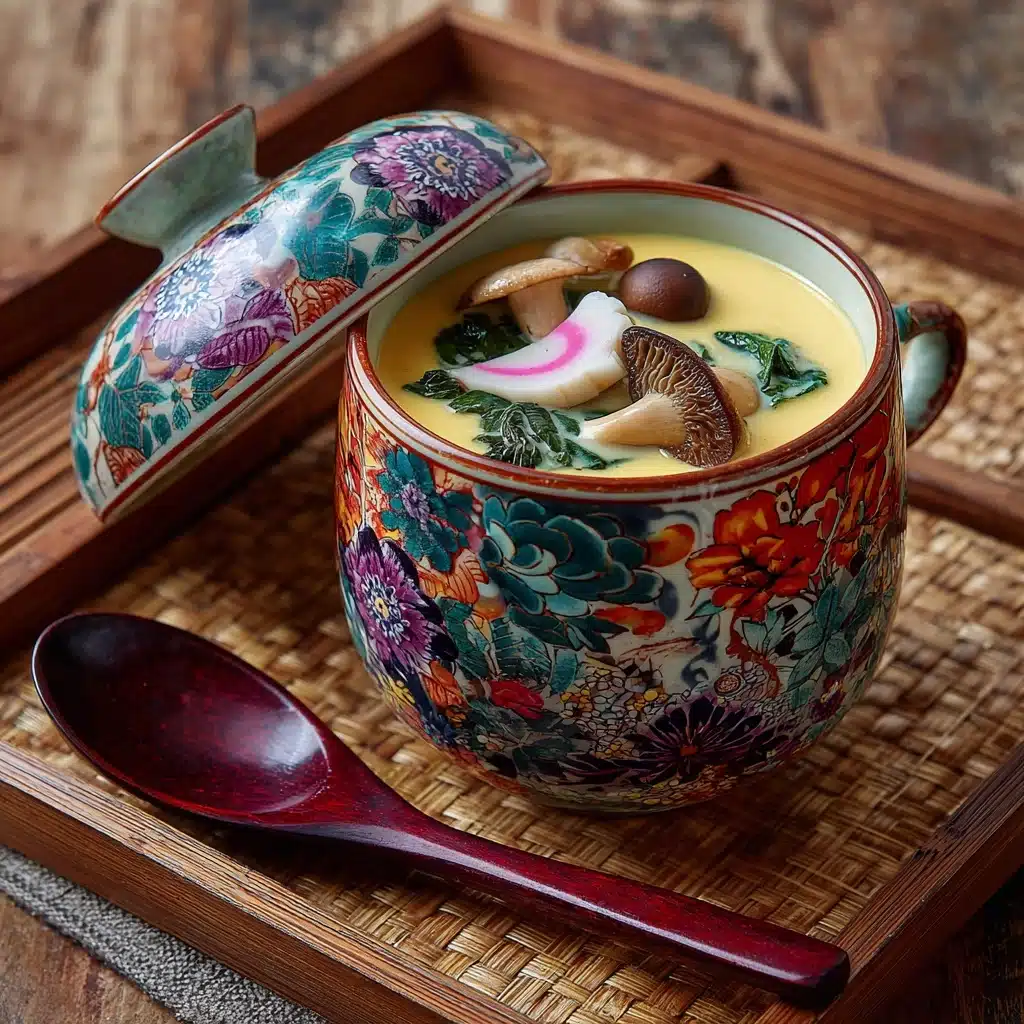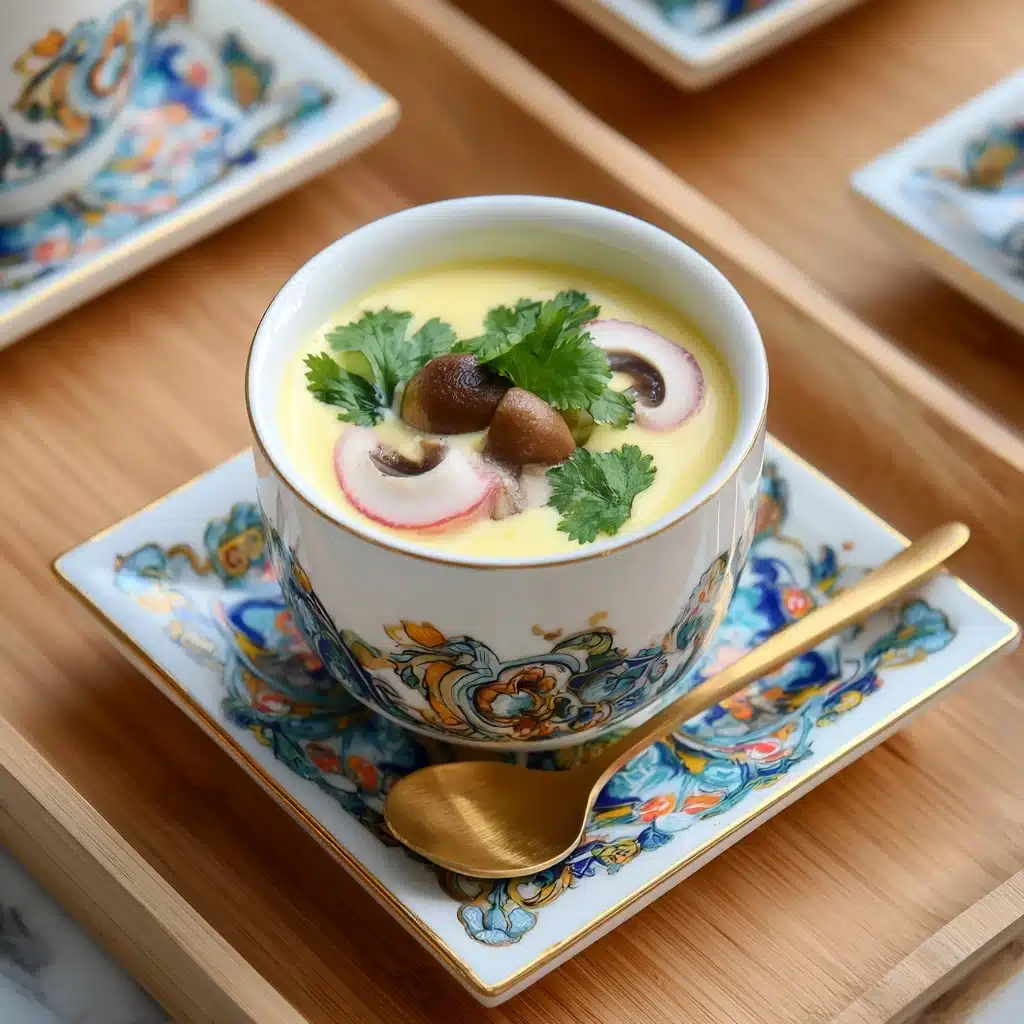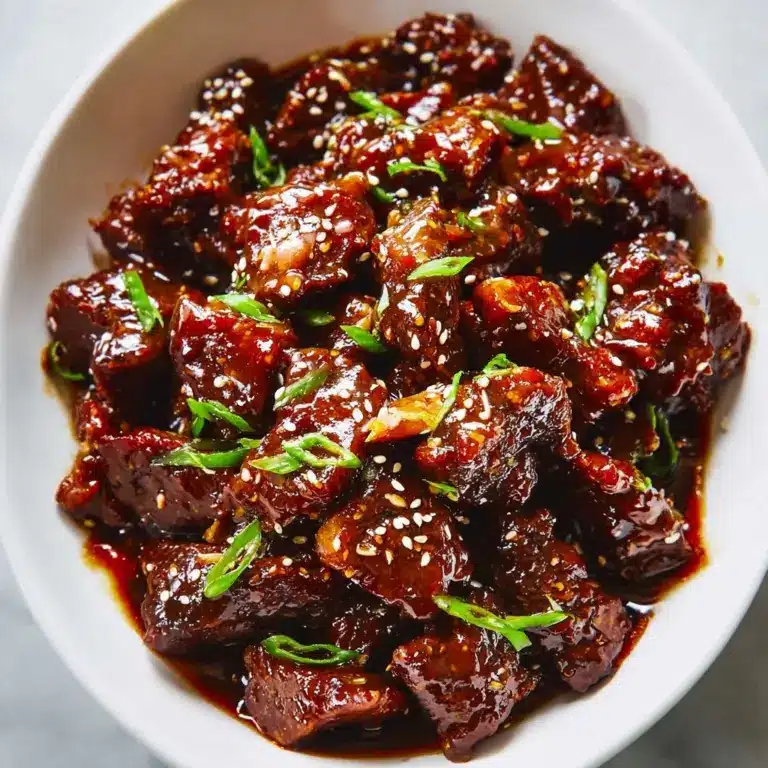Chawanmushi (Japanese Savory Steamed Egg Custard) Recipe
If you have never experienced the silky, delicate pleasure of Chawanmushi (Japanese Savory Steamed Egg Custard), then you are in for a real treat. This traditional Japanese dish is a beautifully smooth custard infused with the subtle flavors of dashi, tender chicken, mushrooms, and kamaboko, all gently steamed to perfection. The magic lies in its softness and the harmonious blend of savory notes that awaken the senses with every spoonful, making it a comforting and elegant appetizer or light meal that always feels special.

Ingredients You’ll Need
The simplicity of Chawanmushi’s ingredients is what makes it so enchanting. Each component contributes something unique—whether it’s the tender texture of chicken, the umami depth from dashi, or the visual charm of mitsuba. Don’t underestimate how these small touches create a big impact on the overall experience.
- Chicken tenders (2): Adds a savory, meaty texture, providing a hearty contrast to the smooth custard; can be omitted for a vegetarian version.
- Sake (1 Tbsp): Marinating the chicken with this tenderizes and infuses subtle flavor.
- Kamaboko – fish cake slices (8): These vibrant slices brighten the presentation and add a mild seafood flavor; skip for vegetarian.
- Shimeji mushrooms (1.8 oz): These delicate mushrooms bring an earthy umami richness that balances the custard beautifully.
- Mitsuba sprigs (4): Japanese parsley adds a fresh, grassy note and lovely color; green onion can be a substitute.
- Ginkgo nuts (8, optional): Adds nutty flavor and a unique textural pop.
- Large eggs (3): The foundation of the steamed custard, delivering that iconic silky texture.
- Dashi (approx. 1¾ cups): This Japanese soup stock infuses the custard with umami and depth; use Kombu Dashi for a vegetarian option.
- Mirin (1 tsp): A touch of sweetness that rounds out the savory elements.
- Soy sauce – light-colored/usukuchi (1 tsp): Keeps the custard light in color while adding gentle saltiness.
- Kosher salt (½ tsp): Just enough seasoning to enhance every ingredient without overpowering.
How to Make Chawanmushi (Japanese Savory Steamed Egg Custard)
Step 1: Preparing Your Cooking Setup
Before diving into the ingredients, set yourself up for success by choosing the right chawanmushi cups—about 200 ml capacity works perfectly. Avoid thick-walled cups since they hinder the gentle steaming process needed to create that smooth, custard-like texture. You’ll also be preparing a hot water bath, which is essential for even cooking, so test fit your cups in a pot and prepare enough water to reach halfway up the sides for a perfect steam bath.
Step 2: Marinating and Preparing Ingredients
Give your chicken tenders a quick bath in sake to tenderize and flavor the meat. While it rests, carefully slice the kamaboko thinly and separate your shimeji mushrooms into small clusters. Folding knots in mitsuba sprigs not only add a traditional aesthetic but also ensure even flavor dispersion. These small preps might seem nit-picky but trust me—they elevate the dish immensely.
Step 3: Making the Silky Egg Mixture
Weighing your eggs is a smart move here for a flawless custard. The magic ratio is 1 part eggs to 2.5 parts dashi, which guarantees a custard that’s firm yet tender. Incorporate mirin, soy sauce, and salt to the mix and whisk gently to marry all the ingredients without creating bubbles. Straining this mixture is a game-changer; it catches any lumps or stubborn chalazae and gives your custard that signature silky-smooth mouthfeel.
Step 4: Assembling the Cups
Layer your ingredients artfully: lay down the marinated chicken first for a hearty base, then scatter the clustered mushrooms and optional ginkgo nuts. Top with colorful slices of kamaboko and your mitsuba knots or scallions. Pour the egg mixture slowly, filling to about 80% capacity, so the ingredients peek through, offering a beautiful bite in every spoonful. Take your time removing any air bubbles—they will disrupt the custard’s delicacy if left unchecked.
Step 5: Steaming to Perfection
Heat the water bath to boiling, then reduce to the lowest setting to maintain a gentle simmer around 176–194ºF (80–90ºC). Gently nestle your cups in the bath, cover with lids, and steam for 20 minutes if using chicken, or 15 minutes if vegetarian. The low and slow steaming wins the cook-off here, ensuring a smooth custard that sets perfectly without any rough curds. A simple skewer test will confirm doneness—if the custard holds with no runny liquid, you’re golden.
How to Serve Chawanmushi (Japanese Savory Steamed Egg Custard)

Garnishes
Traditional garnishes can include a sprinkle of mitsuba leaves or a single ginkgo nut resting on top for color and texture contrast. You might also enjoy a delicate drizzle of soy sauce or a few drops of chili oil for a twist. The beauty of Chawanmushi (Japanese Savory Steamed Egg Custard) is its subtlety—garnishes never overpower but enhance the gentle custard flavors.
Side Dishes
This dish pairs wonderfully with simple yet complementary sides such as steamed rice, pickled vegetables, or a light miso soup. These sides balance the custard’s richness with acidity and texture, creating a harmonious Japanese meal experience that feels thoughtfully composed and satisfying.
Creative Ways to Present
For an impressive presentation, try serving Chawanmushi in elegant porcelain cups or ramekins with lids to retain warmth and invite curiosity. You could also experiment with adding ingredients like shrimp or seasonal mushrooms for a seasonal spin. During special occasions, layering flavors by adding matsutake mushrooms or using a pressure cooker for an ultra-quick version keeps this traditional dish exciting and accessible.
Make Ahead and Storage
Storing Leftovers
If you find yourself with extra Chawanmushi (Japanese Savory Steamed Egg Custard), no worries! Leaving it in its cups, store the custard tightly covered in the refrigerator for up to two days. This makes for an easy snack or quick reheat that doesn’t sacrifice texture or flavor.
Freezing
Freezing is not recommended because this delicate custard’s texture can break down and become watery once thawed. It is best enjoyed fresh or refrigerated for short-term storage to savor its creamy character at its best.
Reheating
To reheat, steaming is the friendliest method. Place the cups back in a steam bath for about two minutes to gently warm without drying or toughening the custard. Avoid microwaving as it tends to create bubbles or rubbery edges, which undermine the luxurious smoothness you worked so hard to achieve.
FAQs
Can I make Chawanmushi without dashi?
Dashi is key to the umami depth in Chawanmushi, but if you don’t have it, a mild vegetable broth or mushroom broth can be used as a substitute. The flavor will be lighter but still enjoyable, especially for vegetarians.
Is Chawanmushi gluten-free?
Yes, this dish can be gluten-free if you use gluten-free soy sauce and check that your dashi ingredients don’t contain any gluten-containing additives. Pure dashi made from kombu and dried fish is naturally gluten-free.
How can I make a vegetarian version?
Simply omit the chicken and kamaboko, and use a kombu dashi instead of fish-based dashi. Add more mushrooms or tofu for texture, and you’ll still achieve that perfect custard feel with rich umami flavor.
Why is there water in my Chawanmushi after steaming?
If you notice liquid water on top, it’s usually because the steaming temperature was too high or the mixture wasn’t strained well. Reduce the heat and strain carefully next time to maintain the custard’s silky, set texture.
Can I prepare the mixture ahead of time?
Yes! You can prepare the egg and dashi mixture a few hours beforehand and keep it refrigerated. Just stir gently again before pouring into cups. Avoid making it too early to keep the custard fresh and sweet.
Final Thoughts
There’s something truly magical about Chawanmushi (Japanese Savory Steamed Egg Custard) that makes every spoonful feel like a warm hug in a cup. Whether you’re new to Japanese cooking or a seasoned enthusiast, this recipe invites you to slow down and enjoy the art of simple, thoughtful flavors. I encourage you to try making it at home—it’s easier than you think and delivers endless comfort and smiles.
Print
Chawanmushi (Japanese Savory Steamed Egg Custard) Recipe
- Total Time: 35 minutes
- Yield: 4 servings 1x
- Diet: Low Fat
Description
Chawanmushi is a classic Japanese savory steamed egg custard that is silky smooth and delicately flavored with dashi, soy sauce, mirin, and a mix of ingredients like chicken, mushrooms, kamaboko, and mitsuba. It makes a comforting appetizer or side dish that showcases the elegance and subtlety of Japanese cuisine.
Ingredients
Protein and Toppings
- 2 chicken tenders, cut into ½-inch pieces (omit for vegetarian)
- 8 slices kamaboko (fish cake), thinly sliced (omit for vegetarian)
- 8 ginkgo nuts, pre-cooked (optional)
- 1.8 oz shimeji mushrooms (about ½ package), trimmed and separated into clusters
- 4 sprigs mitsuba (Japanese parsley) tied in knots or substitute 1 green onion/scallion, thinly sliced
Custard Base
- 3 large eggs (approximately 150 g total without shell)
- 1 ¾ cups dashi (Japanese soup stock) – approximately 375 ml, adjusted according to egg weight; use Kombu Dashi for vegetarian version
- 1 tsp mirin
- 1 tsp usukuchi (light-colored) soy sauce
- ½ tsp Diamond Crystal kosher salt
- 1 Tbsp sake (for marinating the chicken)
Instructions
- Prepare the hot water bath: Place the chawanmushi cups with their lids inside a large pot to check fit. Pour enough water to reach halfway up the sides of the cups, then remove the cups. Cover the pot and bring water to a boil, then turn off the heat to keep it hot but not boiling.
- Marinate chicken: Cut chicken tenders into ½-inch pieces, place in a bowl, add 1 Tbsp sake to coat, and let sit for 10 minutes to tenderize and add flavor.
- Prepare toppings: Thinly slice kamaboko, trim and separate shimeji mushrooms, and tie mitsuba sprigs into small knots (or thinly slice green onion if substituting).
- Make the custard mixture: Crack 3 large eggs into a measuring cup or bowl placed on a kitchen scale and note the weight (about 150 g). Multiply by 2.5 to calculate dashi volume needed (approximately 375 ml). Add the calculated amount of dashi to the eggs, then add 1 tsp mirin, 1 tsp soy sauce, and ½ tsp kosher salt. Whisk thoroughly to combine yolks and whites.
- Strain the mixture: Pour the egg mixture through a fine-mesh sieve into another bowl to remove lumps and ensure a silky smooth texture.
- Assemble the cups: Evenly divide chicken pieces into the bottom of each cup, followed by shimeji mushrooms and ginkgo nuts if using. Layer kamaboko and mitsuba on top. Gently fill each cup about 80% full with the custard mixture, leaving some toppings exposed. Remove any air bubbles by gently stirring with a spoon or popping them with a skewer.
- Steam the custard: Bring the water in the pot back to a boil, then reduce heat to the lowest setting. Carefully place the cups with lids into the hot water bath, cover the pot with the lid slightly ajar, and steam gently for 20 minutes if using chicken, or 15 minutes if vegetarian. Aim for a simmering water temperature between 176–194ºF (80–90ºC) to avoid boiling, which would compromise custard texture.
- Check doneness: Insert a skewer into the center of the custard; if clear liquid comes out, it is done. Alternatively, gently tilt the cup to ensure the custard is set and not runny.
- Serve and enjoy: Remove cups carefully from water, serve hot or warm with a small wooden or lacquer spoon for an authentic experience.
- Storage: Leftovers can be kept refrigerated in their cups for up to 2 days. To reheat, steam for 2 minutes until warmed through.
Notes
- Use cups with thin walls for even heat penetration to achieve a smooth custard texture.
- Cover cups with aluminum foil if lids are unavailable to prevent water condensation from dripping inside.
- Usukuchi soy sauce is preferred to maintain the pale color of the custard; regular soy sauce darkens it.
- Adjust seasoning proportionally if changing the amount of eggs used.
- For a vegetarian version, omit chicken and kamaboko and use kombu dashi instead of fish-based dashi.
- Maintain gentle steaming heat to prevent curdling or a rough texture.
- Variations include adding shrimp or matsutake mushrooms for different flavors.
- An Instant Pot or pressure cooker can be used for quicker preparation.
- Prep Time: 15 minutes
- Cook Time: 20 minutes
- Category: Appetizer
- Method: Steaming
- Cuisine: Japanese
Nutrition
- Serving Size: 1 cup (approximately 200 ml)
- Calories: 110 kcal
- Sugar: 1 g
- Sodium: 350 mg
- Fat: 4 g
- Saturated Fat: 1 g
- Unsaturated Fat: 2.5 g
- Trans Fat: 0 g
- Carbohydrates: 6 g
- Fiber: 1 g
- Protein: 11 g
- Cholesterol: 165 mg
Keywords: Chawanmushi, Japanese egg custard, steamed egg, savory custard, Japanese appetizer, chawanmushi recipe







